C. de la POMELIE
* MEREA : Mediterranean Research Team in Aquaculture
Man has been concerned by aquaculture for thousands of years, but often these traditional rearings feed at the expense of the natural production of the environment. At present, man knows how to master the biological cycle of numerous animal species in rearing while employing intensive methods. He must feed them.
Whatever the species may be -sea-bass, gilthead sea-bream, shrimp … whatever the stage of the biological cycle, the aquaculturist's main objective is to obtain the best profit performance from the biomass in rearing, in other words, the maximum individual growth of the animals with a minimum mortality rate. For this, food plays a primary role, concerning both the quality and the quantities distributed, and the feeding methods employed are fundamental.
Aquaculturists are often classed as hatchery or fattening specialists. Indeed, the specialities and requirements of the hatchery-broodstock, larvae juveniles which must be weaned and those in nurseries or fattening are quite different : especially concerning feeding.
1. HATCHERY PHASE
1.1. Larval rearing
One of the special characters of this first phase is the use of live organisms, algae, rotifers and especially Artemia to feed many of the species in rearing.
- Larvae are very active and do not support fasting. Therefore, a sufficient density of algae or prey must be ensured so that they do not become exhausted in their search for food, especially at the beginning stage.
- On the contrary, prey are live organisms which are not only expensive to produce, but they also modify the quality of the rearing environment by the excretion of ammonia and the consumption of oxygen.
It is in keeping in mind these three fundamental points that the research team at IFREMER are especially those at the PALAVAS station have succeded, after ten years of scientific research, in perfecting the feeding sequences which are presented here in the form of figures.
- Figure 1: Feeding sequence of P. japonicus (shrimp) in rearing: The algae distributed, Chaetoceros calcitrans or Phaeodactylum tricornitum are employed to feed zoea stage of course but also so as to avoid either a slump in the nutritional quality of the Artemia nauplii distributed and or abrupt peaks in ammonia.
- Table 1: Feeding sequence of D. Labrax (sea-bass), at larval rearing stage.
In larval rearing, a great part of the production cost of the animals in caused by feeding, as the algae, rotifers, artemia nauplii or metanauplii are very expensive to produce (Table 2 and 6), Let us underline in particular that for sea-bass larval rearing (Table 7), feeding represents 96 % of the production cost, not counting manual labour for the 45 day old larvae and that for japanese shrimp (Table 8). This is represented by 49 % of the P 3.
From these tables (7 and 8), it is evident that the most significant economy concerning the production costs are expected from feeding.
Important remark: All the economic approaches stated in this document have be calculated on unitary prices (m3 of water, m3 of pressurized air, etc … ) with regards to the facility conditions of the PALAVAS IFREMER station.
1.2. Weaning and nursery
- Weaning or the change over from live feed to inert feed causes a great upset to juveniles in their feeding habits and also in their behaviour.
- The impact that feeding has during this phase of rearing is still important so as to estimate the production cost of the consumable animal. Along with this, feeding will also have as objective the safeguard of the animals who have begun weaning as these have now already reached a considerable production cost.
- As for the Japanese shrimp, the feeding sequence employed (Fig. 2) permits to estimate the importance of feeding in the post-larval rearing phase (Table 9).
- Concerning sea-bass, recent research on the weaning carried out in our station, but which has not yet been edited,has given rise to a new feeding sequence, which improves greatly the production cost of fry. Figure 3 describes the feeding sequence applied up to a recent date.
1.3. Brood-stock
- The objective to reach, and the nutritional requirements of the brood-stock are now fully understood. Thus a great part of the compound food is generally replaced by fresh food.
If for P. vannamei research has proven the influence of the distribution of pellets on the quantity of eggs spawned, the feed for P. japonicus brood-stock is based essentially on fresh mussels and the animals are fed ad libitum, which is around 5% fresh weight per day of the body weight. For the sea-bass, table 10 shows that the ration given is 1.5% dry weight per day, of the body weight, 25% (dry weight) of fresh food seems sufficient so as to obtain satisfactory spawnings.
- Feeding has but a feeble influence on the production cost of brood-stock as is shown in Table 9 (P. japonicus). It is thus illusive to try and make an important productivity benefit from feeding at this phase of rearing. On the contrary, it is advisable to supply a very diversified fresh food of good quality.
2. FATTENING PHASE
Two types of rearings requiring an exogenous feeding entails the adoption of two different policy methods of feeding:
Semi-intensive rearing when the animals mostly obtain their food from the environment. Exogenous feeding is then only a complement of this natural food of high nutritional quality.
On the contrary, in intensive rearing, the food obtained from the environment is more often very scarce. Exogenous food must cover all the requirements of the animals both in quality and quantity.
- The quality of the food distributed is fundamental and its misappreciation can cause real catastrophies in rearings. This quality can be judged from two points:
Nutritional: of other reports of the session.
Organoleptic
The fineness of the grinding has a great influence on the transformation of the pellet.
The Hardness of the pellet: when two hard it is badly accepted.
Buoyancy: Shrimp and sea-bass do not ingest food in suspension.
Powder or dust forms are not ingested.
The granulometry, or diameter of the pellet must be adapted to the size of the animal.
The diameter and the length of the pellet must not be too important
for the sea-bass as it will refuse to fed 
The stability of the pellet in water is very important foe shrimp.
- The compound food can be conserved 3 to 4 months from the date of manufacture which will be furnished on the label and that of the following conditions are respected.
* Temperature: The speed of the chemical reaction, degradation, (Maillard reaction, peroxydation of fats) depends on the temperature. A well aered room will avoid important increases of temperature.
* The relative humidity of the air: certain vitamins are destroyed, mildew can develop if this value becomes important (70%). The storage place must be dry.
* The food delivered in bulk must also be stored in a place which has shelter from the light.
It must be underlined that a badly stored food will not only lack vitamins (vitamin C) but will be especially toxic (peroxyde fats, mildew) and cause irrevocable lesions (kidneys, liver), to the sea-bass.
- Three ratio will permit the definition for feeding in rearing.
* Food rate = Tn = 
QN = quality of food distributed per day to a define of biomass up to present (BM)
* Food conversion rate: 
where TC represents the growth rate.
This parameter which does not integrate mortality has a more scientific than economic value and is taken more so as the instantaneous value. It is especially used to verify the justification of the good rate.
* Conversion index : 
This index is considered either at technical and economic level or at scientific level. In this case, QA represents the quantity of food brought for this rearing or the rearing period and BMf the biomass truely commercialized for example (waste).
- The evolution of the TCA depending on the food rate (figure 4) shows clearly that this is kept at a minimum which also corresponds, at economic level, to a minimum of the production cost.This point is theoretical and depends on several parameters (average weight of the animals,their origin,small sized large sized fish,temperature,salinity,etc…).The aquaculturist whose objective is to reach the maximum growth will try to attain this food rate by giving excess.
- This is how the fishfeed manufacturers define the average values of the fed rates in their technical documents.Table II shows our recommendations for sea-bass rearing in normal French Mediterranean conditions.
3. FOOD DISTRIBUTION METHODS
A good distribution of food tends to minimize the conversion index of the food.This distribution takes into account the behaviour of the animals: For semi-intensive rearings of shrimp,the food is distributed once per day,in the evening before sunset.
- The frequency of meals and their repartition during the day,this for the sea-bass depends on its weight in knowing that the more the distributions are divided out,the better the conversion and growth index will be.On the contrary, while taking into account the behaviour ofP. japonicus,the rearings will only receive one distribution per day before sunset.
- The geographical repartition of the distribution in the rearing enclosure : Thus the shrimp, the pellets are distributed over the maximum surface area of the pond, and for sea-bass fattening reared in cages the pellets are only distributed in the center of the cage.
The methods employed:manual or automatic distribution.
3.1. Manual distribution
- Advantages
Little or no investment
Surveyence of the animal behaviour in raring
With fish one can see the animals eating, this permits ad libitum feeding without waste.
- Disadvantages
Expensive in manual labour
Very demanding for the organization of the manual labour planning.
A quasi utopian dividing up of the ration in numerous feeds.
Preferential hours for feeding which are not compatible with the normal working hours.
Technologically, it is difficult to avoid in certain cases: fresh food, pelleted for the semi-intensive rearing of shrimp.
3.2. Automatic distribution
- Advantages
Distribution of the pellets 7 days a week whatever the manual labour planning may be.
Economy from a manual labour viewpoint
Ad libitum dividing up of the feeds even self-feeding by the animals when a self-feeder is employed.
- Disadvantages
Supplementary investment
Upkeep of the facilities
Risk of over or under feeding if the rations pre-established have been calculated incorrectly.
Different devices can be seen in figures 5, 6, 7 and 8.
Important remark
Automatic distribution can be accompanied by a reduced manual distribution once per day. The behaviour of the fish towards the food (indifference or heavy consumption), permits the avoidance of a notory over or under feeding.
Certainly, the present food is likely to be improved. From a nutritional viewpoint, through research, it is being perfected year after year permitting (this is obligatory) important productivity gains.
But the performances of the rearing -growth, survival, conversion index- and thus the profitability of the aquaculture Enterprise will always be compromised, by bad technology in manufacture, by bad storing and by bad distribution of the food no matter how perfected the formulation may be. Field work carried out at the IFREMER Station of PALAVAS shows that many of the“diseases”encountered by aquacultists are due to a bad management of the feeding.
| Table on the consumption of prey, air and water | Tank no 2, 3, 4 | Special Sea-bass D. labrax | ||||
| Rearing period: | : 17/04/29–06 | |||||
| Rotifers | Nauplii | Métanauplii A1 | Métanauplii A2 | Water | Air | |
| Distribution period | 11 – 14 | 11 – 21 | 21 – 26 | 22 – 45 | 0 – 45 | 0 – 45 |
| Duration in days | 4 | 11 | 16 | 24 | 45 | 45 |
| Peak day | 12 | 20 | 21 | 45 | 45 | 45 |
| Total quantity/JO | 125 | 355 | 325 | 7184 | 5,5 | 0,5 |
| Total quantity/JN | 195 | 540 | 492 | 10942 | 8,4 | 0,8 |
TABLE 1 : LARVAL REARING OF SEA BASS: feeding example
TABLE 2 : ALGAE - ECONOMIC APPROACH
| Unit Cost 100 I FHT | Without manual labour % | With manual labour % | |
Energy | 30 | 60.6 | 23.5 |
Salt | 7 | 14.1 | 5.5 |
Fresh water | 0.5 | 1.0 | 0.4 |
Air + co2 | 7 | 14.1 | 5.5 |
Material | 5 | 10.1 | 4.0 |
Manual labour | 78 | - | 61.0 |
| Total without manual labour | 49.5 | 100 | - |
| Total including manual labour | 127.5 | - | 100 |
Production cost of 100 l of algae
TABLE 3 : ROTIFERS : ECONOMIC APPROACH Cost of 1.106 rotifers
| NATURE | QUANTITY | U.P. Tax free | TOTAL PRICE Tax free | PRICE OF 1 m ROTIFERS Tax free | % | |
| Food | ||||||
| Yeast algae | 75 kg | 5.97 F/kg | 447.75 | 0.0526 | 1.40% | |
| Algae | 7700 l | 1.27 F/1002 | 9779.00 | 1.15 | 26.30 | |
| Electricity | ||||||
| Light | 1036.8 kw | 0.162 | 168.00 | 0.079 | 0.43 | |
| Air conditioning | 58104,0 kw | 0.162 | 9412.90 | 1.107 | 25.40 | |
| Brine (30 mn/week) | 2.394 | 0.162 | 0.40 | 0.00004 | 0.009 | |
| Aeration | ||||||
| 1) | Tank (x2) | 20736 | 0.003 | 74 | 0.008 | 0.18 |
| 2) | Brine (100 1/35 days) | 5040 | 0.003 | 15.12 | 0.001 | 0.02 |
| Water | ||||||
| Fresh | 120 m3 | 4.3 f/m3 | 516.00 | 0.06 | 0.90 | |
| Sea water | 25 m3 | 0.0243 f | 0.6 | 0.0007 | 0.016 | |
| Manual labour | 290 H | 49.00f | 14210.00 | 1.67 | 38.30 % | |
| Salt | 2400 kg | 1.017 f/kg | 2440.8 | 0.28 | 6.40 % | |
| Total | 37064.50 f | 4.36 | ||||
Total cost for 106 rotifiers: 4.36 tax free
TABLE 4 : ARTEMIA - ECONOMIC APPROACH (Cost Ao)
| Unit cost Cheptel=108 A0 FHT | Without manual labour % | With manual labour % | |
| Pumping | - | - | - |
| Heating | 15 | 4.6 | 4.0 |
| Air | 5 | 1.5 | 1.3 |
| Treatment | 15 | 4.6 | 4.0 |
| Cysts | 290 | 89 | 76.4 |
| Manual labour | 55 | 14.5 | |
| TOTAL without manual labour | 325 | 100 | - |
| TOTAL including manual labour | 380 | - | 100 |
PRODUCTION COST OF 108 Ao
TABLE 5: ARTEMIA: ECONOMIC APPROACH (Cost Al)
| NATURE | QUANTITY | U.P. Tax free | TOTAL PRICE tax free | PRICE OF 1 m Tax free | PRICE OF 100 m Tax free | % |
| Number of Ao in fattening | 19,01 m | 372 F/100m | 70717.2 | 3.72 | 372 | 32.80 |
| Warm sea water | 350 m3 | 14.85 kw/h | 1055.60 | 0.055 | 5.55 | 1.086 |
| waste water | 60 m3 | 14.85 | 180 | 0.014 | 1.44 | 0.22 |
| Lightning (2 × 60 × 2) 6 months | 1036,8 | 0.162 | 167.9 | 0.008 | 0.88 | 0.172 |
| Air | 10400 m3 | 0.003 | 933.12 | 0.049 | 4.90 | 0.95 |
| Feeding Ao9 bis | 104.08 kg | 149.70 | 15580.7 | 0.81 | 81.96 | 16.00 |
| Manual labour | 175 h | 49.00 | 8575 | 0.45 | 45.10 | 8.80 |
| TOTAL | 97209.50 | 5.10 | 511 | 100.00 % |
Production cost of 1 m of Ai : 5,11 F
TABLE 6 : ECONOMIC APPROACH (cost A 2)
| NATURE | QUANTITY | U.P. Tax Free | TOTAL PRICE Tax free | PRICE OF 1 m Tax free | PRICE OF 100 m Tax free | % |
| Number of Ao in fattening | 12.52 m | 372F/100 m | 46574.40 | 3.72 | 372 | 58.60 |
| Warm sea water | 570 m3 | 14,85kw/h | 1719.1 | 0.137 | 13.73 | 2.16 |
| Waste water | 60 m3 | 14.85kw/h | 181.0 | 0.074 | 1.44 | 0.226 |
| Lighting | 1728 kw | 0.162 | 279.9 | 0.02 | 2.22 | 0.349 |
| Air | 29600 m3 | 0.003 | 388.2 | 0.031 | 3.10 | 0.48 |
| Feeding Ao9 Bis | 150.22 kg | 147.70 | 22487.90 | 1.79 | 179.6 | 28.2 |
| Manual labour | 160 H | 49.00 | 7840.00 | 0.62 | 62.61 | 9.8 |
| TOTAL | 79469.50 | 6.3 | 634.10 | 100.00 |
Thus production cost of 106A2: 6.34 F.
| PRODUCTION COST | ||||||
| PER UNIT of 2 m3 | For 100.000 45 day old | |||||
| Cost FF | Cost FF | % | % | |||
| Manual Labour | 1 8 5 0 | 2 0 5 6 | 1 8 | |||
| Larvae | 1 2 2 | 1 3 6 | 1 | 1 | ||
| Prey treatment | 8 2 0 3 | 9 1 1 4 | 9 6 | 7 9 | ||
| Fluids | 2 6 6 | 2 9 6 | 3 | 2 | ||
| Total without manual labour | 8 5 9 1 1 | 9 5 4 6 | 1 0 0 | |||
| General total | 1 0 4 4 1 | 1 1 6 0 2 | 1 0 0 | |||
TABLE 7 : Estimate elements of the production cost of sea-bass Larvae of 45 days.
Economic approach : Larval rearing of P. japonicus
| Cost of the rearing unit | Production cost of the population 1 000 P3 | |||
| FHT | FHT | % | % | |
| Animals | 12001 | 2.2 | 43 | 36 |
| Heating | 200 | 0.4 | 7.8 | 6.5 |
| Pumping | 2 | - | - | - |
| Air | 8 | - | - | - |
| Food | 1400 | 2.5 | 49 | 41 |
| Manual labour | 600 | 1 | - | 16.4 |
| Total without manual labour | 2810 | 5.1 | 100 | - |
| TOTAL including manual labour | 3410 | 6.1 | - | 100 |
TABLE 8: PRODUCTION COST OF 1 000 P 3
The most significant profits on the production cost are expected from feeding by the replacement of Artemia nauplii and in part algae by microparticles.
| Breeders | Nauplii | P 3 : Larval rearing | P 23 : Post Larval rearing | |
| Animals | 11% | 75% | 36% | 26,5% |
| Heating | 27,5% | 10% | 6,5% | 11,8% |
| Pumping | 2,7% | 0,6% | / | 1,2% |
| Air | 0,3% | / | / | 0,6% |
| Food | 5,1% | / | 41 | 56,5% |
| Manual Labour | 53,2% | 15,5% | 16,4% | 3,5% |
| Unit Price Tax Free | 120,9 F/0 | 1,62/1000 N | 9/1000 P3 | 48/1000 P23 |
TABLE 9: ANALYSIS OF THE PRODUCTION COSTS
TABLE 10 : The relation between the productivity of sea-bass breedstocks and their daily average ration along with the proportion of fresh feeds in comparison with the total ration.
| SPECIES | SEASON | TANK | PROGRAMMING OF SPAWNING | DAILY AVERAGE RATION IN DRY WEIGHT(%) | PROPORTION OF FRESH FOOD/TOTAL RATION IN DRY WEIGHT (%) | PRODUCTIVITY NUMBER OF EGGS/KG OF FEMALE |
| 1984–85 | 1984–85 | G1 | Staggered | 2,9 | 45 | 362.000 |
| 1984–85 | G2 | Staggered | 2.7 | 44 | 1.000.000 | |
| SEA-BASS | 1984–85 | G4 | Staggered | 1.2 | 35 | 194.000 |
| G7 | 1.5 | 36 | 128.000 | |||
| G8 | Advanced | 1.7 | 31 | 93.000 | ||
| G9 | Normal | 1.3 | 37 | 206.000 | ||
| G10 | Normal | 1.2 | 39 | 281.000 | ||
| G3 | Staggered Delayed | 1.2 | 31 | 154.000 | ||
| 1985–86 | G4 | Staggered Advanced | 1.8 | 18 | 292.000 | |
| G7 | 1.6 | 25 | 117.000 | |||
| G8 | 1.4 | 27 | 120.000 | |||
| G10 | Normal | 1.4 | 28 | 284.000 |
TABLE 11 - FEEDING RATE
• Around 1/3 of the ration with be given at each feed (3 feeds per day)
• Granulometry and average weight of the fish
| AVERAGE WEIGHT | GRANULOMETRY | |
| from 5 to 8 g | “Crumbs” | |
| 8 to 15 g | 1, 5 mm | |
| 15 to 30 g | 2 mm | |
| 30 to 80 g | 3, 2 mm | |
| 80 to 200 g | 4, 5 mm | |
| More than 200 g | 6 mm | |
• Feeding rate depending on the average weight and the temperature
| AVERAGE WEIGHT | Feeding rate/kg of pellets to be distributed for 100 kg of fish | ||
| <15° C | From 15 to 19° C | From 19 to 25° C | |
| From 5 to 8 g | Ad libitum feeling | 2, 8 | 4 |
| 8 to 15 g | 2, 5 | 3 | |
| 15 to 30 g | 1, 7 | 2 | |
| 30 to 80 g | 1, 3 | 1,8 | |
| 80 to 200 g | 1, 2 | 1,5 | |
| More than 200 g | 1 | 1 | |
It is possible to replace part of the ration in pellet form by minced fish knowing that 1 kg of fresh fish = 250 g of pellets.
When manually distributed and especially at low and high temperatures adjust the feeding ration visually.
FIGURE 1 : P. JAPONICUS - LARVAL REARING - FEEDING
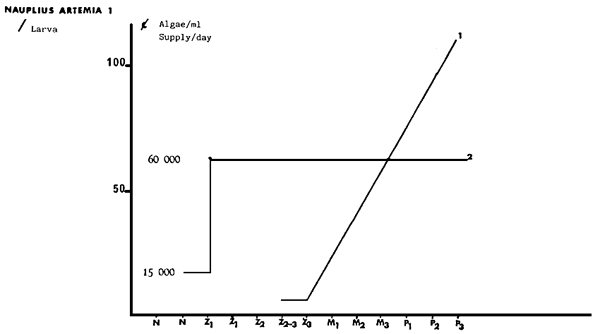
FIGURE 2 : P. JAPONICUS : Post Larval rearing

FIGURE no 3 : WEANING TEST PROTOCOL FOR D. Labrax

FIGURE 4 : EVOLUTION OF THE FEED CONVERSION RATE DEPENDING ON THE FOOD RATE
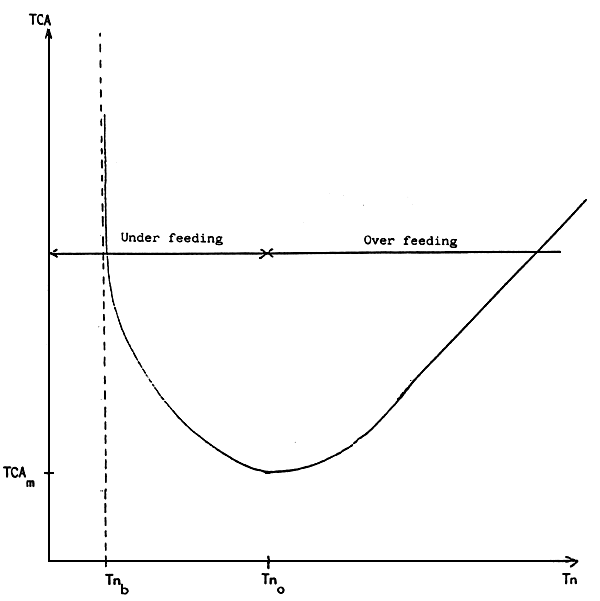
Tnb : Feeding rate covering the basic metabolic requirements
Tno : Optimum feeding rate
TCAm : Minimum feeding conversion rate
FIGURE 5 : AUTOMATIC DISTRIBUTER OF LIVE PREY
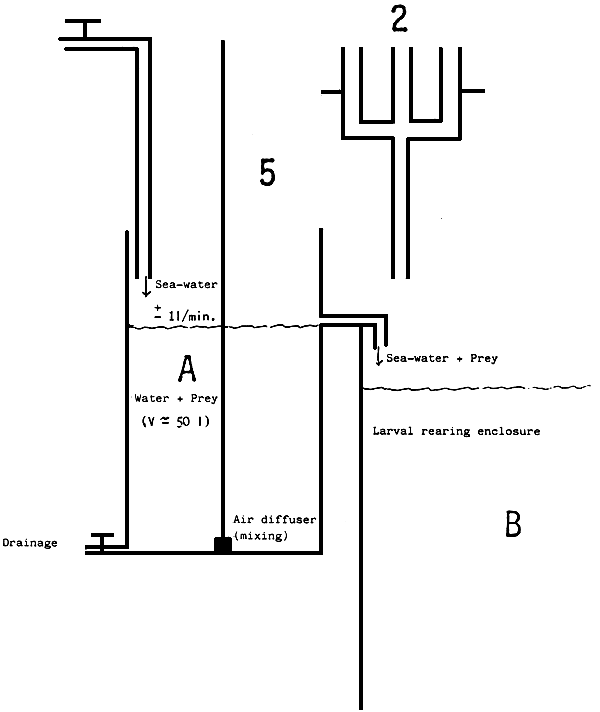

- a simple spring
- a clock system
- a device programming the distribution
The distribution takes places as the belt advances.
FIGURE 6 : Distribution employing conveyor belt (Rehydrated or dry pellets)
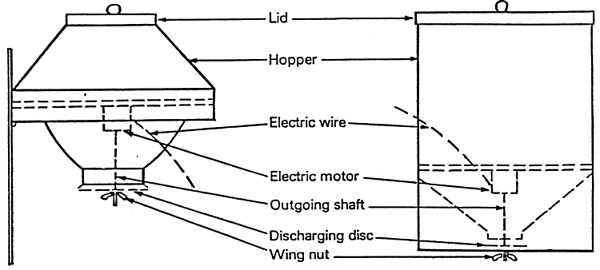
To be installated with a double delay time programmer, for example.
FIGURE 7 : VIBRATING FEEDER (Dry pellets)
FIGURE 8 : EXEMPLE OF SELF FEEDERS (PENDULUM FEEDERS) (dry pellets)
Nos : 610, 630, 650
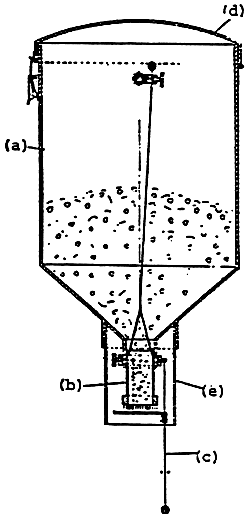 |
a = feed hopper b = tube to set the feed supply. c = pendulum d = Cover e = Plexiglass tube |